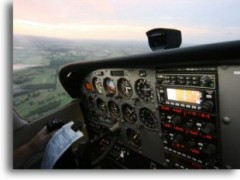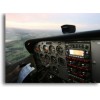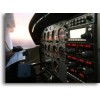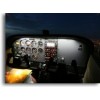Now that you have completed your Private Pilot training it's time to move on to the next step - the Instrument Rating. If you consider using your license for business trips and need to have a more consistent travel schedule rather than being grounded by bad weather with low cloud ceilings, this rating is the logical answer. For those pursuing a career in aviation, this becomes a requirement. The instrument rating is an add-on to your Private Pilot License and allows you to pilot the aircraft during bad weather with low visibilty and cloud layers. Even though you might say that you would rather just be a fair weather flyer, consider that this add-on, being one of the most challenging and rewarding certifications you could seek, will increase your skills and thus your safety even more.
Eligibility Requirements for the Instrument Rating:
Hold a valid and current Private Pilot License
Must Read, Speak, Write, and Understand the English Language
Must pass an FAA Written Test
Must pass an Oral / Practical Exam prior to issuance of the certificate
Aeronautical Experience Requirements under Part 141:
35 hours of Dual Flight Instruction
At least 1 IFR Cross Country
Aeronautical Experience Requirements under Part 61:
50 hours Cross-Country time as Pilot-in-Command in Airplanes
40 hours Minimum Flight Time in Actual/Simulated Instrument Conditions
15 hours dual instruction
3 hours of checkride preparation
Cross-Country IFR
Additional to meet requirement either with instructor or safety pilot as applicable
What to Expect
The advantage of the Part 141 course is that it does not require any additional cross country experience so you can advance immediately from the Private Pilot course to the Instrument Course. You will become more familiar with the aircraft systems especially in how they pertain to the instrument environment. You will also learn to master the complex airspace system and the intricacies of navigation and the use of onboard equipement including your NAV radios and IFR GPS. You quickly progress to what most consider to be the heart of the Instrument Rating: the Approaches. Here you will become familiar with the techniques in flying the precision and non-precision approaches and learning the procedures of flying in the IFR environment. When weather allows you will fly in "actual" instrument conditions and realize the exhileration of breaking out of the clouds and seeing the runway just a few hundred feet away.
Airplane
For the instrument rating you will get to train in both the standard gauge and the G1000 Glass Cockpit Cessna 172S.
Curriculum
For both Part 61 and 141 courses, you will use the proven Cessna Computer based Instruction (CBI) training program as described in the Learn to Fly information page.
Cost
We offer competitive training packages for Private, Instrument, and Commercial Courses at this time. The Instrument Part 141 Course is elligible for student loans provided through SLM Financial. For more information about training with us, please call us at 817-430-0005 or stop by for a tour.






